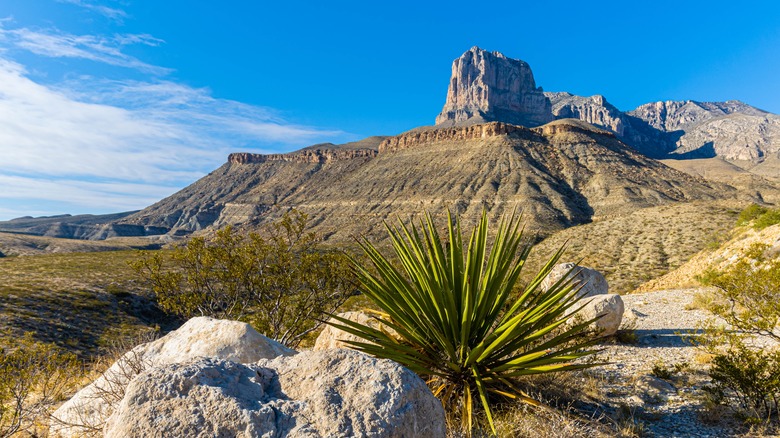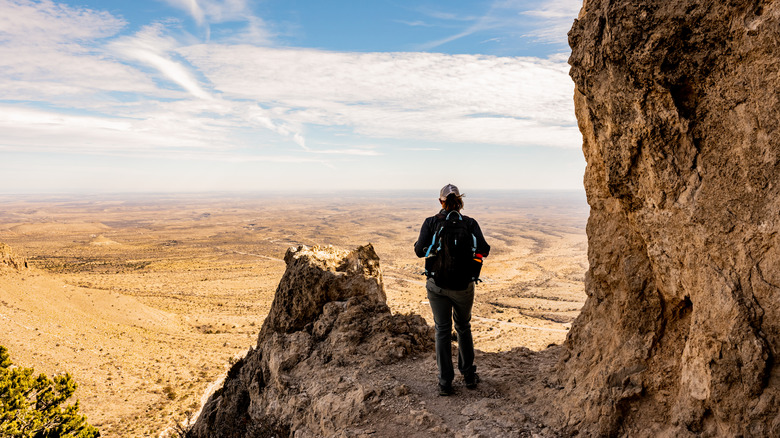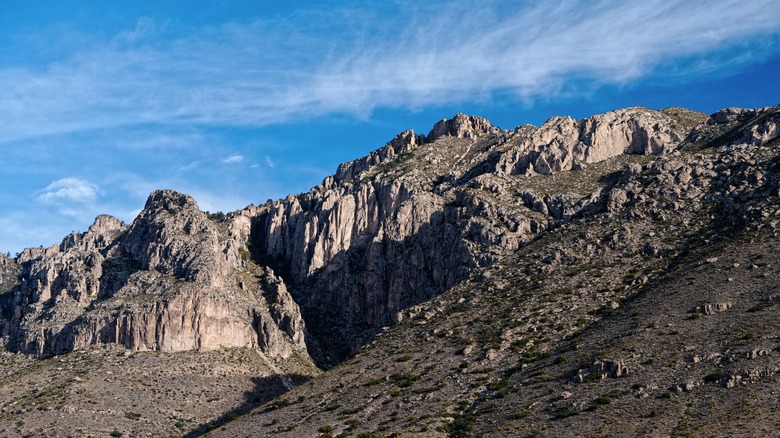This Stunning Southern Destination Is Somehow One Of The US' Least-Visited National Parks
There are 429 national park sites in the United States of America, covering over 84 million acres. It would be really hard to get to all of them in a lifetime (though it's a worthy goal). The big ones like Yellowstone, the Grand Canyon, and Zion are famous all over the world, but some of the lesser-known ones deserve their day in the sun. One national park in Texas is absolutely stunning, and somehow, it's one of the least-visited. In fact, according to USA Today, there were less than 220,000 visitors in 2022, with only about 7,000 more in 2023. (For comparison, Yellowstone got almost 4.5 million in 2023.) This wonderful park is Guadalupe Mountains National Park in West Texas, and you should absolutely move this place to the top of your list.
Sitting about 115 miles east of El Paso, Guadalupe Mountains National Park has so much to offer, with over 80 miles of hiking trails and some incredible views from the mountain peaks. The highest one, Guadalupe Peak, is part of a fossilized sponge reef that is over 260 million years old. The park itself covers 86,000 acres, has plenty of animals to spot, some primitive camping, and even better, lots of space to yourself. Let's take a look at what you need to know before you visit Guadalupe Mountains National Park.
All about Guadalupe Mountains National Park
Guadalupe Mountains National Park was created in 1972 and it's known for the aforementioned Permian fossil reef mountain range, which has 12 exposed miles to explore. (About 400 miles of it is underground.) The reef mountains feature four of the highest peaks in the entire state. The area was once covered by a tropical sea and you can sometimes find marine fossils in the rocks. You can hike these mountains while you're here, or, for a contrast, visit the Salt Basin Dunes, a quiet and sandy-soiled area. The dunes are a fascinating place to visit, with parts of the ground covered by cryptogams, a lichen and fungal combo. When you visit, try not to step on them. This area can be very warm, and there is no water at the trailhead, so make sure to keep your supplies on you, including sunscreen. (Here are some reef-safe sunscreens to try.)
If you'd like to learn more about the area, you can check out the Frijole Ranch Museum at the old ranch headquarters in the park. They have exhibits about the human history of the park, as well as some old buildings to explore like a one-room schoolhouse. Bring lunch to enjoy at the picnic tables there.
You can camp in certain areas across the park (though not at Salt Basin Dunes). It's back-to-basics camping with no showers, hookups, or dump stations, but there are pit toilets, tent pads, and trailer parking. Here is some additional gear you'll want for your camping adventure.
Spectacular hikes and important info
The hiking views in Guadalupe Mountains National Park are exquisite. For the best one, hike up to the Guadalupe Peak Trail, which is 4.2 miles each way, with a 3,000-foot elevation gain. (The steepest part is at the beginning.) For a completely different experience, you can hike a 2.3-mile loop from the Frijole Ranch area to see the water of Smith Spring.
Birders will love it here, and there is a checklist so you can record what you spot. You may see hummingbirds, scaled quail, turkey vultures, roadrunners, and the northern mockingbird. There are also impressive mammals like coyotes, mountain lions, bears, mule deer, javelinas, kit foxes, and elk. Keep these tips in mind to protect yourself from animals while hiking.
There are a few things to know before you go. Fill up on gas, water, and food before you get to the park as there is none for sale there. Download what you need as WiFi can be spotty. Don't trust the time on your cell. You're close to the Central time zone (which your phone might pick up), but the park boundary is in Mountain Time. A park entrance pass is good for seven days, and you can get it here. Keep an eye on the weather as it can get windy, and the mountains sometimes get snow in the winter. Highs in the summer can reach 100 degrees Fahrenheit, and winter can drop to 30. It's a crime that this place isn't visited more, so make this gorgeous park a priority.


